Growth or income?
By Colin Twiggs
July 12th, 2014 11:00 a.m. AEST (9:00 p:m EDT)
Advice herein is provided for the general information of readers and does not have regard to any particular person's investment objectives, financial situation or needs. Accordingly, no reader should act on the basis of any information contained herein without first having consulted a suitably qualified financial advisor.
Research & Investment: Performance update
ASX200 Prime Momentum strategy returned +27.60%* for the 12 months ended 30th June 2014, outperforming the benchmark ASX200 Accumulation Index by +10.17%.
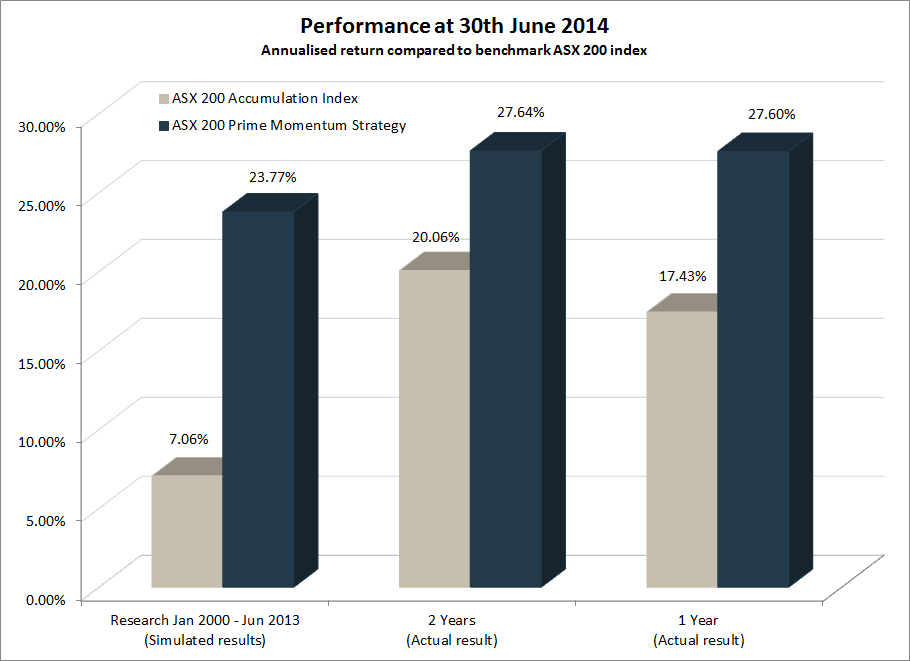
The S&P 500 Prime Momentum strategy has been running eight months, since November 2013, and returned 13.41%* for the period, compared to 13.06% for the S&P 500 Total Return Index. A sell-off of momentum stocks affected performance in April, but macroeconomic and volatility filters indicate low risk typical of a bull market and we maintain full exposure to equities.
* Results are unaudited and subject to revision.
Market bullish despite Europe bank worries
Summary:
- S&P 500 advance to 2000 likely.
- Europe warns of correction.
- China further consolidation expected.
- ASX 200 hesitant.
US market sentiment remains bullish, while Europe hesitates on Portuguese banking worries. As Shane Oliver observed: "Could there be a correction? Yes. Is it start of new bear mkt? Unlikely. Bull mkts end with euphoria, not lots of caution like there is now..."
The S&P 500 found support between 1950 and 1960, as evidenced by long tails on the last two candles, and is likely to advance to the psychological barrier of 2000. 21-Day Twiggs Money Flow recovery above the descending trendline would confirm that short-term selling pressure has ended. Expect retracement at the 2000 level, but short duration or narrow consolidation would suggest another advance. Reversal below 1950 is unlikely, but would warn of a correction to 1900 and the rising trendline.
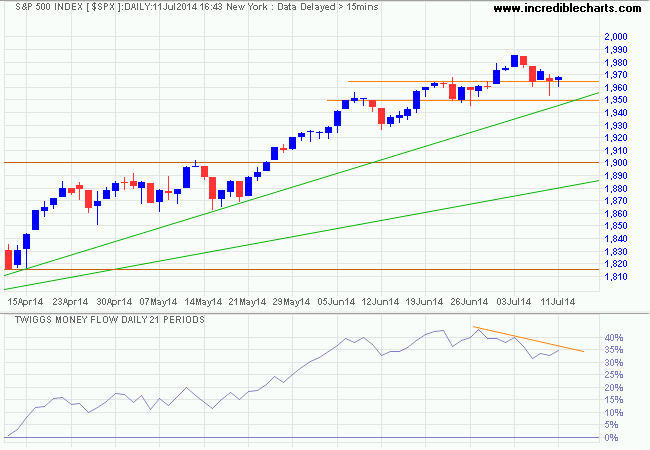
* Target calculation: 1900 + ( 1900 - 1800 ) = 2000
CBOE Volatility Index (VIX) remains at low levels indicative of a bull market.
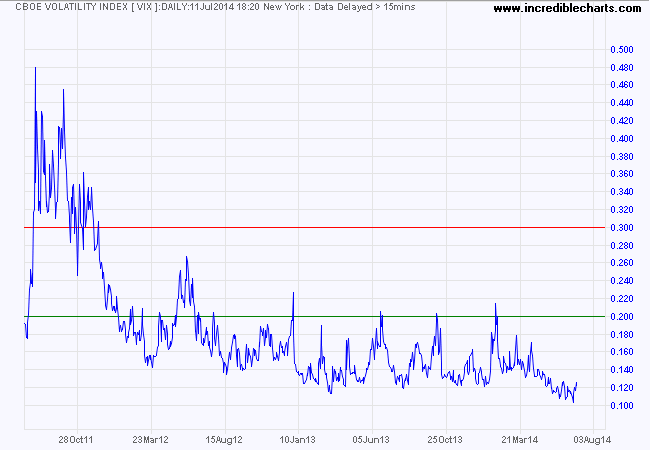
Dow Jones Euro Stoxx 50 broke support at 3200/3230, warning of a correction to the primary trendline at 3000. Solvency doubts over struggling Portuguese Banco Espirito Santo have roiled European markets. Descent of 21-Day Twiggs Money Flow below zero indicates medium-term selling pressure. Recovery above 3230 is unlikely at present.
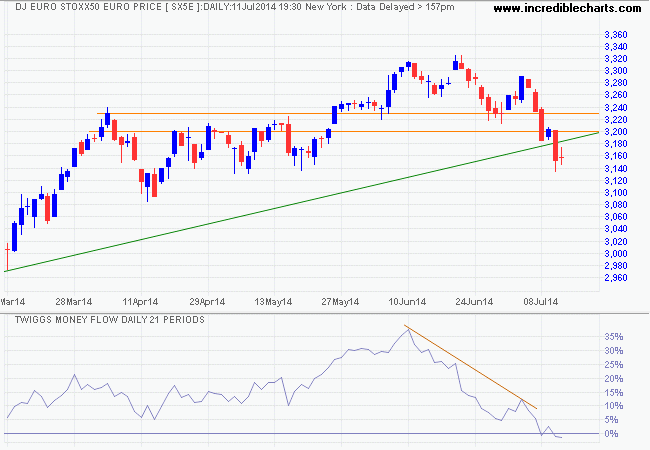
* Target calculation: 3150 + ( 3150 - 3000 ) = 3300
China's Shanghai Composite Index displays strong medium-term buying pressure, with 21-day Twiggs Money Flow troughs above zero. Follow-through above 2060 would indicate another test of 2090. Breach of primary support is unlikely at present, but would signal a decline to 1850*. Further ranging between 2000 and 2150 is expected — in line with a managed "soft landing".
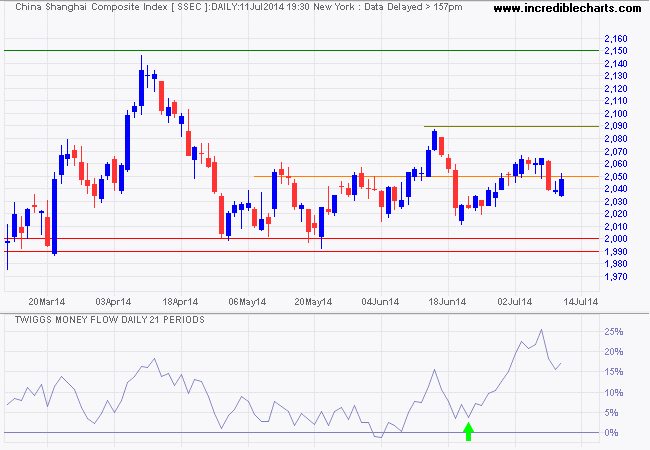
* Target calculation: 2000 - ( 2150 - 2000 ) = 1850
The ASX 200 found support at 5450 and appears headed for another test of resistance at 5550. 21-Day Twiggs Money Flow oscillating around zero, however, continues to indicate hesitancy. Reversal below 5450 would signal another test of 5350, while breakout above 5550 would suggest a long-term advance to 5800*.
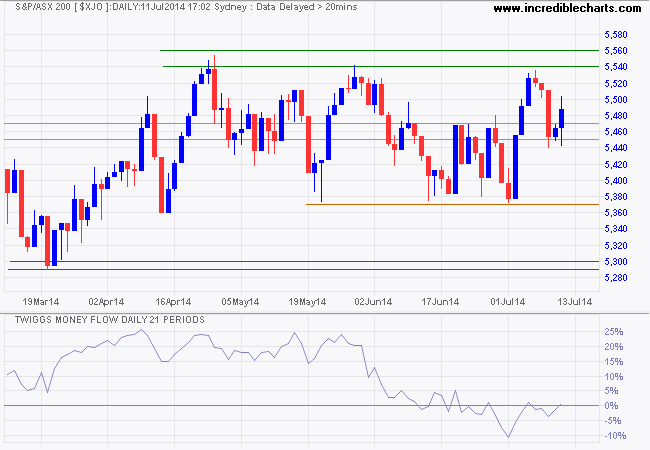
* Target calculation: 5400 + ( 5400 - 5000 ) = 5800
Growth or Income?
Most investors face a decision as to how much of their portfolio to allocate to growth investments and how much to income investments. The mind-set of many income investors is that they cannot afford the volatility of growth investments. The following example illustrates how income investors can use growth investments to protect their portfolio against inflation and enhance overall returns.
Growth investments, historically, have outperformed income investments, but at the expense of greater volatility. They are typically favored pre-retirement by investors with long time horizons who seek to maximise their capital on retirement. Other than improved performance, growth investments also generally receive more favourable tax treatment than fixed income, further enhancing after-tax returns. Income investments historically exhibit lower volatility and are favored by retirees for their consistent income, also by risk-averse pre-retirees who wish to reduce the volatility of their overall portfolio.
Historic Returns
These historic returns to Australian investors from 1981 to 2009 illustrate the differences in returns and volatility. Data was originally provided by AXA:
| Asset class: | Australian stocks | Australian fixed interest | International stocks | Australian REITS | Australian cash |
|---|---|---|---|---|---|
| Annualised return (%) | 11.38 | 10.41 | 10.81 | 10.49 | 9.18 |
| Inflation (%) | 4.41 | 4.41 | 4.41 | 4.41 | 4.41 |
| Real return (%) | 6.97 | 6.00 | 6.40 | 6.08 | 4.77 |
| Standard deviation | 23.32 | 7.60 | 21.41 | 18.75 | 4.95 |
Not all investment strategies are likely to match the broad asset classes, but they are a good starting point for developing an investment strategy.
What the future holds
One thing about the future is certain: it is not going to match the past. It also is not going to match our projections. Without a magic crystal ball, the best we can do is adjust past performance for expected changes and hope we are not too far off course.
My own expectations are that we are entering a low inflation environment. Central banks, after the global financial crisis, are likely to be far more vigilant about rapid credit expansion and asset bubbles. I have therefore adjusted my inflation expectation down to 2.0%. I also expect that low inflation will have greater impact on fixed interest and cash and have adjusted their returns accordingly.
| Asset class: | Australian stocks | Australian fixed interest | International stocks | Australian REITS | Australian cash |
|---|---|---|---|---|---|
| Annual return (%) | 9.00 | 7.00 | 9.00 | 8.00 | 5.00 |
| Inflation (%) | 2.00 | 2.00 | 2.00 | 2.00 | 2.00 |
| Real return (%) | 7.00 | 5.00 | 7.00 | 6.00 | 3.00 |
| Standard deviation | 25 | 10 | 25 | 20 | 5 |
These projections are no more than an educated guess and are used for illustration purposes only. Make your own projections, but understand that unrealistic projections will yield unrealistic results.
Investing for Income
We can now determine how much to allocate to income investments and how much to growth investments.
Take a retired investor whose objective is to earn $60,000 per year (after tax) from investments while protecting capital from inflation.
If he/she earns an average return of 7.0% p.a. on income investments at an average tax rate of 15%, with 2.0% inflation, we arrive at a net return of 3.95% and a required investment of $1.519 million:
| Average return: | 7.00% |
|---|---|
| Less tax at: | 15% |
| After tax: | 5.95% |
| Deduct inflation: | 2.00% |
| Net return: | 3.95% |
| Required income after tax and inflation: | $60,000 |
| Required capital (60,000 x 100/3.95): | $1.519 million |
Adding growth investments
If we recognize hedging against inflation as a long-term goal and not an immediate cash flow need, we can consider funding the inflation element of the portfolio with higher-yielding growth investments.
Income Component
First we calculate the capital required to meet current income needs:
| Average return on income investments: | 7.00% |
|---|---|
| Less tax at: | 15% |
| After tax: | 5.95% |
| Required income after tax: | $60,000 |
| Required income investment: | $1.009 million |
Growth component
Growth investments typically enjoy higher after-tax returns because of improved performance as well as a lower tax component — through capital gains concessions and franking credits on dividends (for Australian investors).
| Average return on growth investments: | 9.00% |
|---|---|
| Less tax at: | 10% |
| After tax: | 8.10% |
| Deduct inflation: | 2.00% |
| Net return: | 6.10% |
| Required income from growth investments ($1.009m x 2.0%): | $20,180 |
| Required growth investment ($20,180 x 100/6.1): | $0.331 million |
| Total required capital: | $1.340 million |
Using growth investments to fund the inflation component reduces required capital to $1.340 million, a reduction of $179,000. Alternatively, if we invest the previously determined capital amount of $1.519 million, we should average close to $11,000 of additional income (after tax and inflation) each year. With higher inflation rates, the difference is even greater.
Remember that this example does not take into consideration your personal needs and circumstances. Also, taxation and investing for retirement are complex subjects and we recommend that you consult a professional adviser before making any decisions.
That's all for today. Take care.
Peace is an armistice in a war that is continuously going on.
~ Thucydides, History of the Peloponnesian War
Disclaimer
Research & Investment Pty Ltd is a Corporate Authorized Representative (AR Number 384 397) of Andika Pty Ltd which holds an Australian Financial Services Licence (AFSL 297069).
The information on this web site and in the newsletters is general in nature and does not consider your personal circumstances. Please contact your professional financial adviser for advice tailored to your needs.
Research & Investment Pty Ltd ("R&I") has made every effort to ensure the reliability of the views and recommendations expressed in the reports published on its websites and newsletters. Our research is based upon information known to us or which was obtained from sources which we believe to be reliable and accurate.
No guarantee as to the capital value of investments, nor future returns are made by R&I. Neither R&I nor its employees make any representation, warranty or guarantee that the information provided is complete, accurate, current or reliable.
You are under no obligation to use these services and should always compare financial services/products to find one which best meets your personal objectives, financial situation or needs.
To the extent permitted by law, R&I and its employees, agents and authorised representatives exclude all liability for any loss or damage (including indirect, special or consequential loss or damage) arising from the use of, or reliance on, any information. If the law prohibits the exclusion of such liability, such liability shall be limited, to the extent permitted by law, to the resupply of the said information or the cost of the said resupply.
Important Warning About Simulated Results
Research & Investment (R&I) specialise in developing, testing and researching investment strategies and systems. Within the R&I web site and newsletters, you will find information about investment strategies and their performance. It is important that you understand that results from R&I research are simulated and not actual results.
No representation is made that any investor will or is likely to achieve profits or losses similar to those shown.
Simulated performance results are generally prepared with the benefit of hindsight and do not involve financial risk. No modeling can completely account for the impact of financial risk in actual investment. Account size, brokerage and slippage may also diverge from simulated results. Numerous other factors related to the markets in general or to the implementation of any specific investment system cannot be fully accounted for in the preparation of simulated performance results and may adversely affect actual investment results.
To the extent permitted by law, R&I and its employees, agents and authorised representatives exclude all liability for any loss or damage (including indirect, special or consequential loss or damage) arising from the use of, or reliance on, any information offered by R&I whether or not caused by any negligent act or omission.
